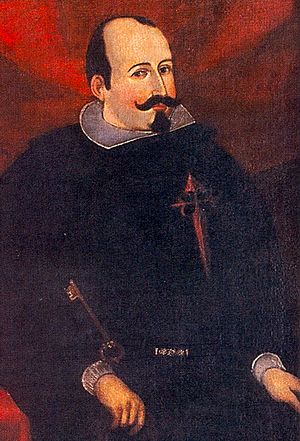Luis Jerónimo de Cabrera, 4th Count of Chinchón facts for kids
Quick facts for kids
Luis Jeronimo de Cabrera
Count of Chinchón
|
|
|---|---|
 |
|
| 14th Viceroy of Peru | |
| In office January 14, 1629 – December 18, 1639 |
|
| Monarch | Philip IV |
| Preceded by | Diego Fernández de Córdoba |
| Succeeded by | Pedro de Toledo |
| Personal details | |
| Born | 1589 Madrid |
| Died | 28 October 1647 Madrid |
Luis Jerónimo Fernández de Cabrera Bobadilla Cerda y Mendoza (born 1589 in Madrid, died October 28, 1647 in Madrid) was an important Spanish nobleman. He was known by his title, the 4th Count of Chinchón.
He held many important jobs, including being the Treasurer of Aragón. Most notably, he served as the Viceroy of Peru from January 14, 1629, to December 18, 1639. A viceroy was like a governor who ruled a colony in the name of the king.
His first wife, Ana de Osorio, is famous in history. Some people believed she was the first European to be cured by a special medicine called quinine. They also thought she brought this medicine to Europe. However, later discoveries showed this story might not be true.
Contents
Early Life and Family Connections
Luis Jerónimo Fernández de Cabrera Bobadilla was born in Madrid in 1589. He came from a powerful family that was very close to the Spanish royal family.
His parents were Diego Fernández de Cabrera, the third Count of Chinchón, and Inés Pacheco. His parents were first cousins, which was common in noble families at that time.
A Royal Visit to Segovia
In 1613, Luis Jerónimo was in charge of the Alcázar of Segovia, a famous castle. That year, Prince Charles of England visited Segovia. This visit was part of a plan for him to marry a Spanish princess.
The Count of Chinchón showed Prince Charles around the castle. He even had special coins made at the Segovia mint and gave them to the Prince as a gift. In the evening, there was a big party with knights on horseback. Prince Charles gave the Count a special jewel to thank him.
Serving as Viceroy of Peru
Luis Jerónimo became the Viceroy of Peru in 1629. This was a very important role, as he governed a large part of the Spanish Empire in South America.
During his time as viceroy, he faced some challenges. He helped put down rebellions by the Uru and Araucano Native American groups.
He also supported exploration. He sent a third expedition to explore the Amazon River. This expedition was led by Cristóbal de Acuña.
Strengthening the Colony
The Count of Chinchón worked to make the colony stronger. He made the colonial navy bigger and built defenses for the port of Callao. Callao was a very important port city in Peru.
He also made some strict rules about trade. He stopped direct trade between Peru and New Spain (which is now Mexico). He also put strict rules on Portuguese Jewish traders in Lima, the capital of Peru.
In addition to these actions, he helped education. He started two new departments for studying medicine at the University of San Marcos.
The Story of Quinine
There is a famous story about how quinine came to Europe. Quinine is a medicine used to treat malaria, a serious fever.
In 1663, an Italian writer named Sebastiano Bado wrote a story. He claimed that in 1638, the Countess of Chinchón became very sick with malaria. A governor from another area, Juan López de Canizares, told the viceroy about a cure: the bark of the quinaquina tree.
According to Bado, the medicine was given to the Countess, and she got better. He said that in 1639, the Countess returned to Spain and brought a lot of this special bark with her. This was believed to be the first time quinine was brought to Europe.
The True Story of Quinine
However, in 1930, the official diary of Viceroy Fernández de Cabrera was found. This diary showed that Bado's story was not completely true.
The diary revealed that Ana de Osorio, the Count's first wife and the Countess of Chinchón, had actually died in Spain years before her husband became viceroy of Peru. It was his second wife, Francisca Henríquez de Ribera, who went with him to South America. She was healthy and never got sick with malaria.
The Count himself had fevers sometimes, but he was never treated with the bark. Also, his second wife never returned to Spain. She died on the way back, in the port of Cartagena, Colombia.
Because of these discoveries, historians now believe Bado's story is incorrect. Instead, a Jesuit priest named Barnabé de Cobo (1582–1657) is now given credit for bringing cinchona bark to Europe. He brought the bark from Lima to Spain in 1632.
The famous scientist Carl Linnaeus later named the group of trees that produce quinine "Cinchona." He did this to honor the Countess, even though the story about her was later found to be untrue.
See also Jesuit's bark.
Later Life and Return to Spain
After his time as viceroy ended in 1639, Luis Jerónimo Fernández de Cabrera went back to Spain.
He became an important advisor to the king, Philip IV of Spain. He even joined the King on military campaigns in different parts of Spain, like Navarre, Aragon, and Valencia.
He passed away in Madrid in 1647.
See also
 In Spanish: Luis Jerónimo Fernández de Cabrera y Bobadilla para niños
In Spanish: Luis Jerónimo Fernández de Cabrera y Bobadilla para niños

